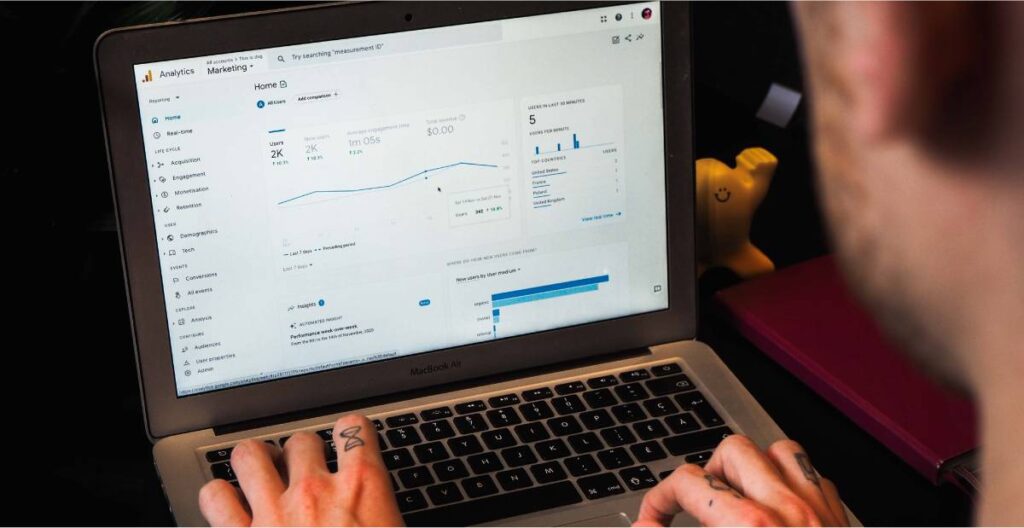In our last article, we told you all about the basics of digital marketing and gave a rundown on what we believe are the top three elements of a great digital marketing strategy. Now we are going to delve deeper into search engine optimisation, better known as SEO. While SEO may seem like an intimidating or overwhelming topic, it’s an essential part of your online presence and shouldn’t be avoided simply because it’s challenging. We’re here to break SEO down into easy-to-understand, actionable steps to help your business become more visible online!

In this blog, we will walk you through the process of setting up a strong foundation for your SEO, to increase your visibility and get more traffic to your website. Use our guide to become an SEO pro in no time and reach out to us at Somer Design for more targeted advice.
What is Search Engine Optimisation (SEO)?
SEO stands for search engine optimisation. Essentially, SEO is the process of trying to improve the search visibility of your website. This means that when someone searches for your services or products in Google, your website presents in the SERP (search engine results page) as a solution.
How to Measure SEO Success
There are three key measures of SEO success: rankings, traffic, and conversions. If you see results in all these areas, SEO can help to increase your revenue and grow your business. Let’s take a closer at each:
Rankings: Refers to how well your keywords rank on Google. If you’re not on page 1, you’re nowhere! That’s because the first page of Google captures over 75% of all clicks. Beyond simply ranking for keywords, you need to be ranking for the right keywords. Knowing whether a keyword is worth ranking for depends on two factors: relevance and volume.
Keyword volume refers to how many people are searching for that keyword in your location. Meanwhile, relevance refers to whether the search intent is aligned with your goals. To determine whether a keyword is right and relevant for your business, ask yourself these questions about the exact phrase:
- Is it relevant to what I offer?
- Does it make sense they’d be searching for our business?
- Does it have a substantial keyword volume?
- If you answer yes to all 3, chances are, it’s a great keyword for your SEO campaign!
When it comes to rankings, we recommend targeting your main services. Plus, you should only have one target keyword per page.
Traffic: If you’re ranking for the right keywords, it’s inevitable you’ll get more impressions (features in the search results) which leads to more traffic (people accessing your site). It’s very important to note that the only traffic SEO can influence is organic traffic. The other forms of traffic such as direct, paid, and referral, are not influenced by SEO and should not be deemed as SEO results.
Conversions: The third and final measure of SEO success is conversions. This refers to whether your website visitors become an active lead. Conversions can be measured in a few different ways:
- Phone calls
- Purchases
- Lead magnet downloads
- Online bookings
- Emails
- Contact form completions
Other data like contact page visits cannot be measured as conversions because they only show intention to convert, not actual conversion.
What Can SEO Achieve?
SEO has many benefits, including:
- SEO can help to increase the traffic to your website, which can result in more customers and revenue.
- SEO can help to build brand awareness and credibility, which can lead to a stronger reputation and more business opportunities.
- SEO is a long-term marketing strategy that can generate sustainable results.
- SEO can be relatively cost-effective, especially when compared to other marketing channels.
- SEO can help you to target specific audiences and markets, which can result in more qualified leads.
- SEO can help you to improve the overall user experience on your website, which can lead to more conversions.
- SEO can give you a competitive advantage in your industry.

How Do You Optimise a Website?
Search engine optimisation is a complex and detailed task that must be approached with a long-term mindset. That’s because SEO results don’t occur overnight. Instead, SEO success requires patience, trial and error, and strategic enhancements. SEO results cannot be achieved with a checklist of generic tasks – it requires customisation and careful analysis to generate meaningful outcomes.
There are four pillars to SEO: on-page optimisation, off-page optimisation, technical SEO, and content SEO. Each of these pillars is important in its own way, and if you want to achieve good SEO results, you need to focus on all of them.
- On-page optimisation: This is all about making sure your website and its content are as search engine friendly as possible. This includes things like optimising your title tags and meta descriptions, using the right keywords, and making sure your site is easy to navigate.
- Off-page optimisation: This refers to all the SEO activities you can do outside of your website to help improve your rankings. This includes things like building links and directories.
- Technical SEO: Technical SEO is all about making sure your website is technically sound and can be easily indexed by search engines. This includes things like optimising your website’s code, using the right hosting solution, and ensuring your site is mobile-friendly.
- Content: SEO is not just about optimising your website for the search engines, it’s also about creating high-quality content that is relevant to your target audience. This includes things like blog posts, articles, infographics, and videos
If you want to achieve good SEO results, you need to focus on all four pillars of SEO.
How to Know if Your SEO is Working
SEO is one of the most important aspects of online marketing, and it can be difficult to know if your SEO is working correctly. In order to get the most out of your SEO, you need to be able to track its effectiveness and make changes as needed. Here are five ways to know if your SEO is working.
1. Check your SEO goals
Make sure that your SEO goals are realistic and achievable. If your goal is to rank number one for a highly competitive keyword, it may take some time to achieve this. However, if you are ranking in the top three for a less competitive keyword, this is a good sign that your SEO is working.
2. Check your SEO progress frequently
You should check your SEO progress on a regular basis. This can be done using Google Analytics or other web analytics tools. These tools will show you how much traffic you are receiving from organic search, and how this traffic is converting into customers or leads.
3. Check your SEO keywords
Make sure that the keywords you are targeting with your SEO are ones that people are actually searching for. You can use Google AdWords Keyword Planner to research keyword popularity and competition. If you are targeting a keyword that is not popular, it may be difficult to rank for that keyword. However, if you are targeting a keyword that is popular, but has low competition, this is a good sign that your SEO is working.
4. Get an audit by an SEO professional
If you want to be absolutely sure that your SEO is working, you can get an SEO audit by a professional. This will give you an unbiased opinion on how well your SEO is working and what improvements can be made.
5. Reassess after 1, 3, and 6 months
SEO is a long-term strategy, and it can take 1-3 months to see results. After this initial period, you should reassess your SEO to see how well it is working. If you are not seeing the results you want, make changes to your SEO strategy. If you’re not seeing competitive rankings, increased traffic, and conversions after 6 months, it’s certainly time to reassess your SEO approach, or your choice of SEO company.
SEO is a complex and ever-changing field, but if you track your progress and make changes as needed, you can be sure that your SEO is working.

Tracking SEO: Your Guide to Google Analytics
The first step of SEO 101 is to familiarise yourself with Google Analytics – an indispensable tool for helping you manage and track the success of your website.
What is Google Analytics?
Google Analytics helps you to verify the impact your digital marketing strategies are having on your business by tracking what happens on your website and consolidating it into useful data. It helps you to track the traffic driven to your website from other platforms such as your social media campaigns or organic search to help you identify what you’re doing right, and what you should improve.
What does Google Analytics track?
After uploading your tracking code to your website code, you’ll be able to track:
- Traffic Volume – How many people are visiting your website.
- Where They Came From – How are they finding and accessing your website.
- Who, How, Where, When and Why – More information on the users that visit, what time they interact, what they look at, what device they’re visiting from etc. Remember, when measuring SEO success, look at your organic traffic and conversions.
- Conversions – How many leads and sales you’re attracting.
And plenty more.
Utilising Data Reports
Once Google Analytics begins to track and collect the appropriate data for you, it’s time to learn how to access and understand the reports so you can use them to your advantage.
It can be difficult not to get overwhelmed by the sheer amount of data reports at first, and the end goal is to save time, not add to it. Many of the reports in Google Analytics repeat similar data in a range of ways so here are the main focus areas we would recommend as a beginner:
- Audience: Audience reports show you how many users have interacted with your website during a given time period and allow you to clearly track growth or loss. More importantly, though, you are able to access more information like if they are a new or returning user, and about the audience demographic, so you can clearly see if you’re successfully targeting your core audience.
- Acquisition: Acquisition reports let you know how people are finding your website, from direct, to organic search, to social media or email campaigns. It allows you to see where your marketing is going right, and where it’s not sparking enough interest.
- Conversions: Conversion reports allow you to create and track goals, whether you want people to sign up for a newsletter, or purchase a product, these actions can be tracked so you can see the customer’s journey to that point, where they came from and ultimately if your marketing has paid off.
- Realtime: Realtime reports give you an overview of what’s happening on your website at that very moment. You can see the locations, what pages people are currently on, whether the traffic came organically or directly from a link, and track conversions.

Measure and Adjust Your Tactics
Measuring your data with Google Analytics is going to give you an eagle-eye view of the ins and outs of your website. As you get a better understanding of the above reports you’ll be able to quickly adapt your digital marketing plan to support your business goals. Perhaps you’re not seeing as many conversions as you’d like, and you notice that your current demographic is 25-35 females when your product is for a 60+ male. This lets you know that it’s time to research your keywords, content and competitors once more to get your plan back on track and in front of the people you want.




